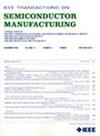Machine Learning on Multiplexed Optical Metrology Pattern Shift Response Targets to Predict Electrical Properties
IF 2.3
3区 工程技术
Q2 ENGINEERING, ELECTRICAL & ELECTRONIC
引用次数: 0
Abstract
Doing high throughput high accuracy metrology in small geometries is challenging. One approach is to build easily measurable proxy targets onto dies and make a predictive model based on those signals. We use optical Pattern Shift Response (PSR) proxy targets to build predictive models of the electrical characteristics of devices in the Back End Of Line (BEOL). Given the wide choice of PSR targets, we explore how to select combinations of them to maximise the utility of the features for building an accurate Machine Learning (ML) model; we call this approach Multiplexed Optical Metrology. We also explore the trade-off between chip area dedicated to targets and achievable accuracy. We run ML experiments using different selections of targets measured at different stages of BEOL processing: post-lithography and post-Chemical-Mechanical-Planarisation (CMP). Our results show that a) reasonable predictive performance can be achieved for a reasonable area budget; b) ML model performance across target families varies significantly, thus justifying the need for careful selection of targets; c) longitudinal measurements of targets increases accuracy for no extra area penalty; d) increasing the number of targets gives some improvement in accuracy for a dataset of this size, but relatively small compared to the increase in area budget needed. Ultimately we aim to do die-level yield prediction using these techniques. We discuss how collecting a larger dataset with appropriate yield information is the logical next step to achieving this.利用多路复用光学计量模式偏移响应目标的机器学习来预测电气特性
在小型几何结构中进行高通量、高精度测量具有挑战性。一种方法是在模具上建立易于测量的替代目标,并根据这些信号建立预测模型。我们使用光学模式偏移响应(PSR)代理目标来建立生产线后端(BEOL)器件电气特性的预测模型。鉴于有多种 PSR 目标可供选择,我们探讨了如何选择这些目标的组合,以最大限度地利用这些特征来建立精确的机器学习 (ML) 模型;我们将这种方法称为多路复用光学计量学。我们还探索了专用于目标的芯片面积与可实现的精度之间的权衡。我们使用在 BEOL 处理的不同阶段(光刻后和化学机械平坦化 (CMP) 后)测量的不同目标选择进行 ML 实验。我们的结果表明:a) 在合理的面积预算下,可以实现合理的预测性能;b) 不同目标系列的 ML 模型性能差异很大,因此需要仔细选择目标;c) 纵向测量目标可以提高准确性,而不会增加额外的面积损失;d) 增加目标数量可以在一定程度上提高这种规模数据集的准确性,但与所需增加的面积预算相比,提高的幅度相对较小。我们的最终目标是利用这些技术进行芯片级良率预测。我们将讨论收集具有适当良率信息的更大数据集如何成为实现这一目标的合理的下一步。
本文章由计算机程序翻译,如有差异,请以英文原文为准。
求助全文
约1分钟内获得全文
求助全文
来源期刊

IEEE Transactions on Semiconductor Manufacturing
工程技术-工程:电子与电气
CiteScore
5.20
自引率
11.10%
发文量
101
审稿时长
3.3 months
期刊介绍:
The IEEE Transactions on Semiconductor Manufacturing addresses the challenging problems of manufacturing complex microelectronic components, especially very large scale integrated circuits (VLSI). Manufacturing these products requires precision micropatterning, precise control of materials properties, ultraclean work environments, and complex interactions of chemical, physical, electrical and mechanical processes.
 求助内容:
求助内容: 应助结果提醒方式:
应助结果提醒方式:


